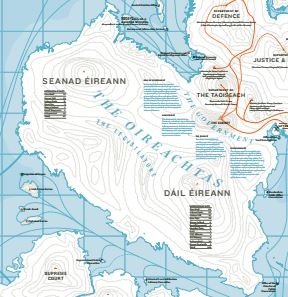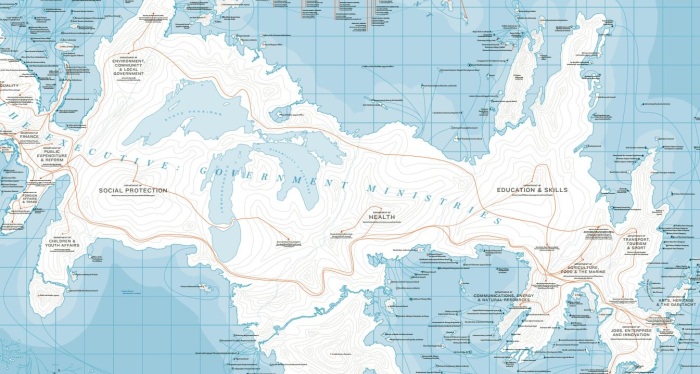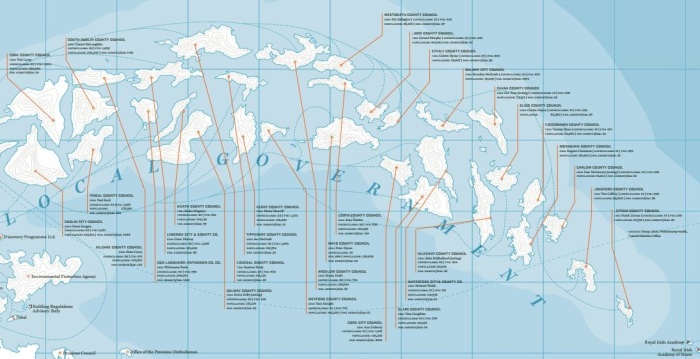1.1
JUDICIARY

The Judiciary is combined of 7 courts. The line of courts is in the order as follows;
The District Courts, The Circuit Courts, The Central Criminal Courts, The High Courts and then The Supreme.
The Court of Criminal Appeal is there to handle cases that used to go to The High Court but to allow them to handle more important cases, the Court of Criminal Appeal came about.
The Special Criminal Court allows for privacy in their cases (24 hour protection) There is no jury.
THE OIREACHTAS

The Oireachtas holds The Dáil Éireann and The Seanad Éireann. The President of Ireland (Michael D. Higgins) is also a part of The Oireachtas.
The relationship between The Oireachtas, The Taoiseach, The People of Ireland, The EU, and The Local Governments can be seen in 1.2. Formal Framework of The Irish Government.
MINISTRIES
All Ministries are appointed by The Taoiseach of Ireland. The most important ministry is The Department of Finance, as shown by the proximity to the department of The Taoiseach. See 1.3.
LOCAL GOVERNMENT
There are 31 City and County Councils. The largest ( the two with the most money spent on) Are Dublin City Council and Cork County Council. These two are also the most important (closest in proximity to The Taoiseach). Next in importance are South Dublin City Council, Fingal County Council and Kildare County Council. The least important are Leitrim County Council and Longford County Council.
QUANGOS
A Quango is a department that The Government supplies monetary funds for but has no control over decisions that take place.
Office of Press Ombudsman
The office of Press Ombudsman handle cases of a defamatory nature relating to media publishing. If a person is unhappy about something that is published in the media in relation to themselves (either is goes against their rights to privacy or a different code of conduct), they can write to the Office of Press or Office of Press Ombudsman. They then decide whether they should print a retraction and an apology or not.
Dublin Bus
The Dublin Bus is another company funded by the government however run by an independent body. Dublin Bus supplies buses through the whole of Dublin, and Bus Éireann runs the buses outside of Dublin.
Irish Water
Irish Water is a relatively new body and also one that caused a lot of controversy in the country.
1.2.

This area of the map of the state shows us exactly who directly elects, nominates, is accountable to and appoints each member of The Oireachtas, government, the courts, the local governments and the European Parliament.
It is the responsibility of the People of Ireland to directly elect members of the European Parliament, members of Dáil Éireann, the Local Government, and The President of Ireland. In turn the Local Government and Dáil Éireann elect the members of Seanad Éireann.
The Local Government and The European Parliament are situated outside of The Oireachtas however they are still accountable to The People of Ireland.
The President is situated slightly above the circle of The Oireachtas, as he is seen as above the Dáil and Seanad. He appoints the head of each section of The Courts, The Taoiseach and The Ministers in Government, however it is the Taoiseach’s responsibility to nominate the Ministers and Ministers of State. Although The Government as a whole appoints The Ministers of State. The Dáil nominates The Taoiseach.
The Government is accountable to Dáil Éireann and The Courts are accountable to The Oireachtas. The Public Service is accountable to The Government and also The Ministers of State.
1.3.
To begin to assess the location and balance of powers within the map, I’ll start by examining the departments with the largest land mass. The land mass given to each department is based on the money allocated to them as of the 2015 budget.

Social protection is the largest with 36.4% of the budget spent here. Next is health, where 23.8% is spent from the 2015 budget. Education and Skills has 16.8%. It then goes in order as follows;
Justice(4.3%),Transport(3.0%),Environment, Community & Local Gov.(2.5%),Agriculture, Food & The Marine(2.3%),Children & Youth Affairs(1.9%),Public Expenditure & Reform(1.9%),Defense(1.7%),Jobs, Enterprise & Innovation(1.5%),Foreign Affairs & Trade(1.3%),Finance(0.8%), Communications, Energy & Natural Resources(0.8%),Arts, Heritage & The Gaeltacht(0.5%),The Taoiseach(0.3%)
So, their land mass shows the money spent on each department, however, their importance is shown by their proximity to the department of The Taoiseach. As shown on the map is it seen that in closest proximity there is firstly The Oireachtas. After that, the Department of Justice & Equality. Then Defense, and Finance.
The furthest department from The Taoiseach is Arts, Heritage & The Gaeltacht. Followed by Jobs, Enterprise & Innovation. Then Transport, Tourism & Sport, and The Department of Agriculture, Food and The Marine.
2.1.

2.1.There are 31 City and County Councils with 949 members in them. Dublin City Council and Cork County Council are the largest.
2.2.Executive power is shared between the council and the Chief Executive. Representative powers are elected every 5 years. Members can nominate themselves or by local government elector in the area concerned, or by a person in a political party. Councillors are paid an average of 31,600 in salary, allowances, expenses, and fees.
Councillors have no individual power, but collective power over planning, sanitation, roads, and housing policies. The strengths of the local government include the influence they have to make changes, according to Paul McCauliffe, Councillor in Dublin City Council, Fianna Fail. Another Strength is that they are not under the party whip like the members of The Dáil. It is not rigid and there is no coalition.
A disadvantage would be the communication levels between the Local Government and The People.
2.3. Dublin City Council has a revenue budget of :
€ 803.56 million for 2016
This covers all expenditure for things such as ;
- Council services, e.g. housing, roads, water, litter, parks, fire brigade
- Procurement & supplies, e.g. IT equipment, transport, etc.
- Payroll
The budgets are managed by the councils department of Finance.
The Council receives their funds from things such as;
- Sale of goods & services, e.g. rent, parking fees: € 280.56 million
- Commercial Rates: € 320.30 million
- Government Grants: € 156.34 million
- Local Property Tax/GPG: € 6.8 million
- Net Credit Balance: € 27.16 million
- Pension Related Deduction €12.40 million